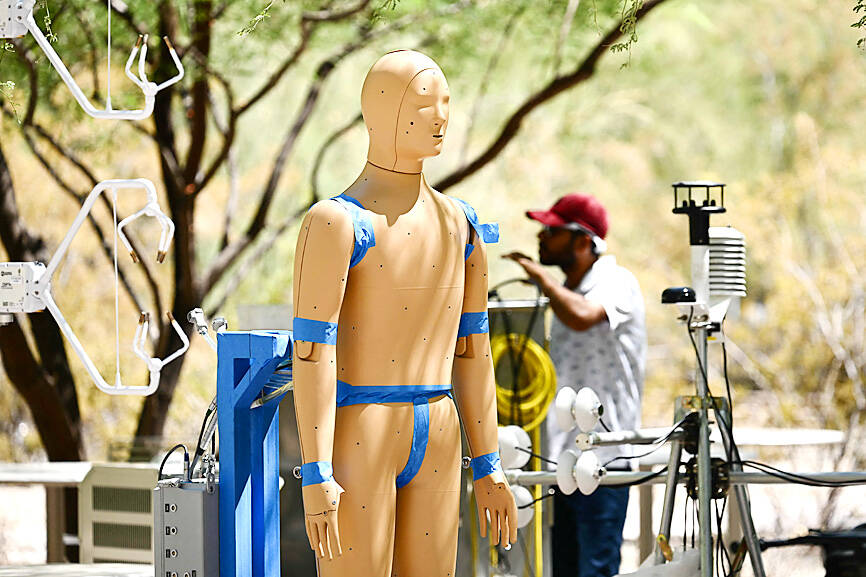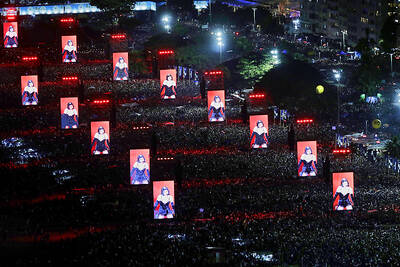What happens to the body when a human gets heatstroke? How can people protect themselves on a warming planet? To answer these burning questions, Arizona researchers have deployed a robot that can breathe, shiver and sweat.
The southwestern state’s capital, Phoenix, is enduring its longest heat wave in history: On Friday, the mercury exceeded 43°C for the 22nd day in a row, an ominous demonstration of what is to come in a world affected by climate change.
For humans, such heat represents a potentially lethal threat, one that is still not fully understood, but for ANDI — a one-of-a-kind humanoid robot at Arizona State University — it is a lovely day out.

Photo: AFP
“He’s the world’s first outdoor thermal mannequin that we can routinely take outside and ... measure how much heat he is receiving from the environment,” said Konrad Rykaczewski, associate professor at the university’s School for Engineering of Matter, Transport and Energy.
ANDI is “a very realistic way to experimentally measure how a human person responds to extreme climate” without putting people themselves at risk, Rykaczewski said.
At first glance, ANDI — which stands for Advanced Newton Dynamic Instrument — resembles a simple crash-test dummy, but its epoxy and carbon fiber skin conceals a treasure trove of technology, such as a network of connected sensors that assess heat diffused through the body.
ANDI also has an internal cooling system and pores enabling it to breathe and sweat.
There are 35 independent thermal zones and, like humans, the robot — which cost more than US$500,000 to build — sweats more from its back.
Until now, only a dozen or so mannequins of this type existed, and none of them could venture outdoors. They were mainly used by sports equipment manufacturers to test their technical clothing in thermal chambers.
Researchers hope the robot will provide a better understanding of hyperthermia — that is, when a body overheats, a condition that is threatening a growing proportion of the world’s population as a result of global warming.
For obvious ethical reasons, “nobody measures core temperature increase while somebody’s getting heatstroke,” Rykaczewski said.
Yet the effects of heat on the human body are still not fully comprehended, and ANDI gives researchers a chance to understand them.
Accompanied by MaRTy (Mean Radiant Temperature), a mobile weather station that measures the heat reflected by the buildings around it, the robot is taking its first steps outside in Phoenix — an ideal laboratory in which to prepare for tomorrow’s climate.
“How do we change what we wear? How do we change our behavioral patterns and adjust them to temperatures that are of this order of magnitude?” Rykaczewski said.
The ANDI robot is also infinitely reprogrammable.
The research team can make “digital twins of the mannequin to look at different segments of the population,” said Jennifer Vanos, a climatologist involved in the project.
For example, the older a person gets, the less they sweat, while young people need different protection from athletes or people in poor health. With ANDI, scientists can simulate the thermoregulatory mechanisms specific to each individual.
They can also test the robot in a variety of situations. For example, Phoenix is dry — what about humid heat? How does the human body cope in hot winds? Their research is likely to be useful for designing heat-resistant clothing, rethinking urban planning and protecting the most vulnerable.
In Phoenix, which opens dozens of cooling centers for the homeless every summer, their findings could guide the actions of social workers.
“How long should a person stay in a cooling center to cool off, so that their core temperature goes down to a level that’s safe again? We can answer that question with ANDI,” Vanos said.
The team also dreams of developing low-cost sensors to be used on building sites to adjust working hours according to the heat actually felt on site and the health of the workers — rather than based on general weather conditions.
That could be a “step towards better safety than just these blank recommendations per city, per state, per country,” Rykaczewski said.

Kehinde Sanni spends his days smoothing out dents and repainting scratched bumpers in a modest autobody shop in Lagos. He has never left Nigeria, yet he speaks glowingly of Burkina Faso military leader Ibrahim Traore. “Nigeria needs someone like Ibrahim Traore of Burkina Faso. He is doing well for his country,” Sanni said. His admiration is shaped by a steady stream of viral videos, memes and social media posts — many misleading or outright false — portraying Traore as a fearless reformer who defied Western powers and reclaimed his country’s dignity. The Burkinabe strongman swept into power following a coup in September 2022

‘FRAGMENTING’: British politics have for a long time been dominated by the Labor Party and the Tories, but polls suggest that Reform now poses a significant challenge Hard-right upstarts Reform UK snatched a parliamentary seat from British Prime Minister Keir Starmer’s Labor Party yesterday in local elections that dealt a blow to the UK’s two establishment parties. Reform, led by anti-immigrant firebrand Nigel Farage, won the by-election in Runcorn and Helsby in northwest England by just six votes, as it picked up gains in other localities, including one mayoralty. The group’s strong showing continues momentum it built up at last year’s general election and appears to confirm a trend that the UK is entering an era of multi-party politics. “For the movement, for the party it’s a very, very big

ENTERTAINMENT: Rio officials have a history of organizing massive concerts on Copacabana Beach, with Madonna’s show drawing about 1.6 million fans last year Lady Gaga on Saturday night gave a free concert in front of 2 million fans who poured onto Copacabana Beach in Rio de Janeiro for the biggest show of her career. “Tonight, we’re making history... Thank you for making history with me,” Lady Gaga told a screaming crowd. The Mother Monster, as she is known, started the show at about 10:10pm local time with her 2011 song Bloody Mary. Cries of joy rose from the tightly packed fans who sang and danced shoulder-to-shoulder on the vast stretch of sand. Concert organizers said 2.1 million people attended the show. Lady Gaga

SUPPORT: The Australian prime minister promised to back Kyiv against Russia’s invasion, saying: ‘That’s my government’s position. It was yesterday. It still is’ Left-leaning Australian Prime Minister Anthony Albanese yesterday basked in his landslide election win, promising a “disciplined, orderly” government to confront cost-of-living pain and tariff turmoil. People clapped as the 62-year-old and his fiancee, Jodie Haydon, who visited his old inner Sydney haunt, Cafe Italia, surrounded by a crowd of jostling photographers and journalists. Albanese’s Labor Party is on course to win at least 83 seats in the 150-member parliament, partial results showed. Opposition leader Peter Dutton’s conservative Liberal-National coalition had just 38 seats, and other parties 12. Another 17 seats were still in doubt. “We will be a disciplined, orderly